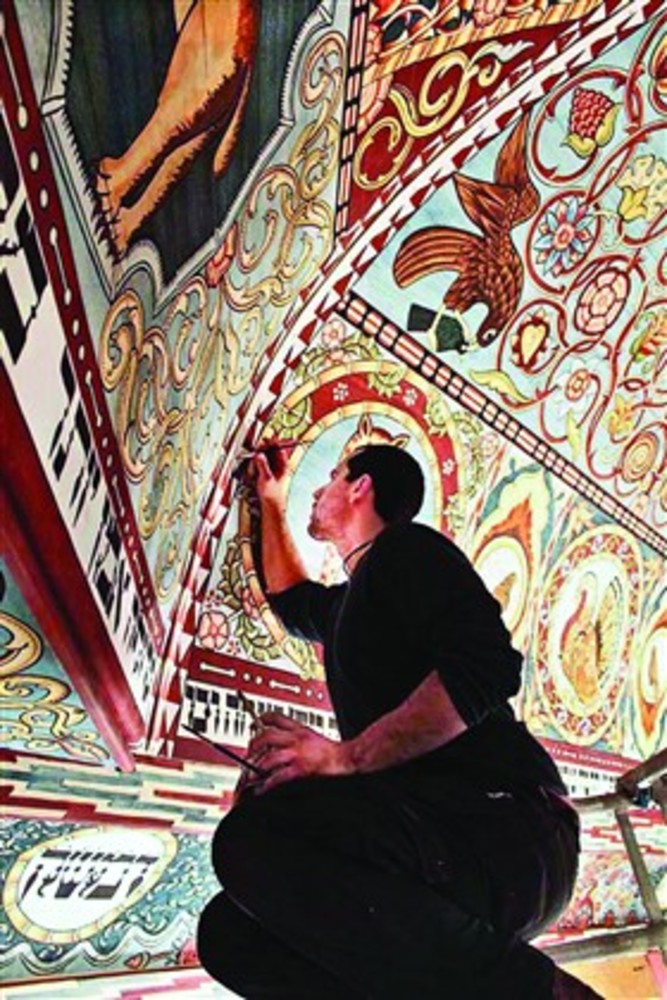Arts Emanu-El hosts events honoring reawakening Jewish culture in Poland
 Jason Loik paints the reconstructed ceiling.
Jason Loik paints the reconstructed ceiling.
Fact: Prior to World War II, there were at least 1,000 wooden hand-built synagogues scattered throughout Poland – on the outside, drab and ordinary, but on the inside a world of color, ornate decoration, and beautifully rendered Hebrew calligraphy, with elements of the exotic and fantastical.
Fact: By 1939, every one of these Jewish architectural treasures was gone. Almost no records remain of what they looked like or how they were built.
Fact: In 2005, American art Professors Rick and Laura Brown and their students aimed to research and reconstruct, in Poland, one of these grand wooden synagogues, using authentic materials and methods. But with almost no historical or visual record about the techniques, art, culture and everyday life of these buildings, they faced a daunting task.
Fact: Prior to World War II, there were at least 1,000 wooden hand-built synagogues scattered throughout Poland – on the outside, drab and ordinary, but on the inside a world of color, ornate decoration, and beautifully rendered Hebrew calligraphy, with elements of the exotic and fantastical.
Fact: By 1939, every one of these Jewish architectural treasures was gone. Almost no records remain of what they looked like or how they were built.
Fact: In 2005, American art Professors Rick and Laura Brown and their students aimed to research and reconstruct, in Poland, one of these grand wooden synagogues, using authentic materials and methods. But with almost no historical or visual record about the techniques, art, culture and everyday life of these buildings, they faced a daunting task.
Fact: In 2014, the breathtaking, colorful, ornate and fantastical roof of the reconstructed Gwozdziec Synagogue was installed as the central exhibit in Warsaw’s POLIN Museum of the History of Polish Jews.
Fact: On Oct. 24, beginning at 7:30 p.m. at Temple Emanu-El, in Providence, Rhode Islanders will have a chance to learn the story, encounter the challenges and feel the deep rewards that the Browns and their team experienced while bringing Gwozdziec Synagogue back to life. Their remarkable project is preserved in the visually stunning documentary “Raise the Roof,” a film filled with close-up views of a rescued Jewish cultural treasure. In fact, viewers would not be able to get a closer, more vibrant look at the synagogue’s wonderful roof and bimah unless they traveled to Warsaw.
The film begins with the Browns, founders of Handshouse Studio and faculty at the Massachusetts College of Art, as they explore the beauty and cultural significance of Poland’s 18th-century wooden synagogues and as they decide to reconstruct the elaborate roof and painted ceiling of the Gwozdziec Synagogue. Along the way, they grapple not just with the echoes of World War II, when these buildings were destroyed by the Nazis, but also with warped timber, tricky paints and period hand tools.
But that is not all. The story continues as their all-volunteer team of 300 young artists and architects learn to hand-carve building frames from raw timber, mix paints from crushed seeds and bark, decipher colors from faint photos, and write in the Hebrew calligraphic style of that time.
Eventually, the project turns into a grand mission as the team digs into Polish archives to learn about the synagogue’s original artists, as they meet with the chief rabbi of Warsaw for help in deciphering the Hebrew in faint photos, and as they tour Poland to engage its citizens in the project.
The film also focuses on several of the young Jewish volunteers as they awaken to and deepen their roots in Polish Jewry.
Then, at the climax of the film, this remarkable artistic team must hand over their treasured work to a construction crew so it can be installed in Warsaw’s new museum dedicated to Polish Jewry. What a triumphal moment, yet also a painful moment, as power drills and machined screws dig into the lovingly wrought, handcrafted panels, tiles and boards. What a story!
To enhance the audience’s appreciation of the Gwozdziec Synagogue project, the screening of “Raise the Roof” will start with a short preview by Krista Lima, a Massachusetts artist who served on the Browns’ artistic leadership team and who appears in the film. She will speak about her experiences in the field and then respond to questions after the film.
Earlier in the day, Rabbi Wayne Franklin, of Temple Emanu-El, will share his photos and talk about his encounter with the synagogue this past summer, when he led a group to Poland. Franklin’s talk is part of the Lunch and Learn series at Temple Emanu-El; Polish treats will be featured on the Shabbat Kiddush menu for that day.
The Oct. 24 screening of “Raise the Roof” is one of two events that Arts Emanu-El at Temple Emanu-El is presenting this fall and both events are open to the community.
On Nov. 21, at 7:30 p.m., Arts Emanu-El will host an evening of music and film with a screening of “The Return of the Violin,” another amazing story in the history of Polish Jewry, this time focused on a violin and a Polish Jewish violinist, and with ties to the birth of the Israel Philharmonic Orchestra and American violinist Joshua Bell.
After the film, violinist Maya Ramchandran, of the New England Conservatory of Music, will perform two movements from the piece featured in the film: Brahms’ Violin Concerto in D Major.
Tickets for both events go on sale three weeks prior to the event.
To purchase tickets for the Oct. 24 screening of “Raise the Roof” at Temple Emanu-El, go to TEProv.org or send a check to: Temple Emanu-El, 99 Taft Ave., Providence, RI 02906. Ticket prices include the film, the preview and post-film discussion, and light refreshments. Early purchase, $8; at the door, $10.
(“Raise the Roof” is made available to Arts Emanu-El by the National Center for Jewish Film, Brandeis University.)
LINDA SHAMOON is co-chair of Arts Emanu-El at Temple Emanu-El.







